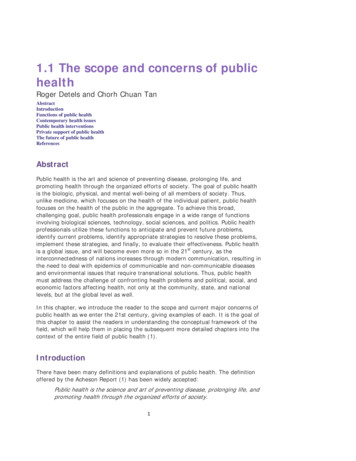
Transcription
1.1 The scope and concerns of publichealthRoger Detels and Chorh Chuan TanAbstractIntroductionFunctions of public healthContemporary health issuesPublic health interventionsPrivate support of public healthThe future of public healthReferencesAbstractPublic health is the art and science of preventing disease, prolonging life, andpromoting health through the organized efforts of society. The goal of public healthis the biologic, physical, and mental well-being of all members of society. Thus,unlike medicine, which focuses on the health of the individual patient, public healthfocuses on the health of the public in the aggregate. To achieve this broad,challenging goal, public health professionals engage in a wide range of functionsinvolving biological sciences, technology, social sciences, and politics. Public healthprofessionals utilize these functions to anticipate and prevent future problems,identify current problems, identify appropriate strategies to resolve these problems,implement these strategies, and finally, to evaluate their effectiveness. Public healthis a global issue, and will become even more so in the 21st century, as theinterconnectedness of nations increases through modern communication, resulting inthe need to deal with epidemics of communicable and non-communicable diseasesand environmental issues that require transnational solutions. Thus, public healthmust address the challenge of confronting health problems and political, social, andeconomic factors affecting health, not only at the community, state, and nationallevels, but at the global level as well.In this chapter, we introduce the reader to the scope and current major concerns ofpublic health as we enter the 21st century, giving examples of each. It is the goal ofthis chapter to assist the readers in understanding the conceptual framework of thefield, which will help them in placing the subsequent more detailed chapters into thecontext of the entire field of public health (1).IntroductionThere have been many definitions and explanations of public health. The definitionoffered by the Acheson Report (1) has been widely accepted:Public health is the science and art of preventing disease, prolonging life, andpromoting health through the organized efforts of society.1
This definition underscores the broad scope of public health and the fact that publichealth is the result of society’s efforts as a whole, rather than that of singleindividuals.In 2003, Detels defined the goal of public health as:The biologic, physical, and mental well-being of all members of societyregardless of gender, wealth, ethnicity, sexual orientation, country, or politicalviews.This definition or goal emphasizes equity and the range of public health interests asencompassing not just the physical and biologic, but also the mental well-being ofsociety. Both the World Health Organization (WHO) and Detels’ goals or definitionsdepict public health as being concerned with more than the mere elimination ofdisease.To achieve the WHO goal of ‘health for all’, it is essential to bring to bear manydiverse disciplines to the attainment of optimal health, including the physical,biologic, and social sciences. The field of public health has adapted and appliedthese disciplines for the elimination and control of disease, and the promotion ofhealth.Functions of public healthPublic health is concerned with the process of mobilizing local, state/provincial,national and international resources to assure the conditions in which all people canbe healthy (2). To successfully implement this process and to make health for allachievable public health must perform the functions listed in Table 1.1.1.Table 1.1.1 Functions of public health1.2.3.4.5.6.7.8.9.10.11.12.13.Prevent disease and its progression, and injuries.Promote healthy lifestyles and good health habits.Identify, measure, monitor, and anticipate community health needs.Formulate, promote, and enforce essential health policies.Organize and ensure high-quality, cost-effective public health and health-care services.Reduce health disparities and ensure access to health care for all.Promote and protect a healthy environment.Disseminate health information and mobilize communities to take appropriate action.Plan and prepare for natural and man-made disasters.Reduce interpersonal violence and aggressive war.Conduct research and evaluate health-promoting/disease-preventing strategies.Develop new methodologies for research and evaluation.Train and ensure a competent public health workforce.Source: Adapted from Office of the Director, National Public Health Performance Standards Program. 10 essentialpublic health services. [Online]. Centers for Disease Control; 1994. EssentialPHServices.htm) and Pan American HealthOrganization. Essential public health services. [Online]. 2002. hf e.html)2
Public health identifies, measures, and monitors community and global health needsthrough surveillance of disease and risk factor (e.g. smoking) trends. Analysis ofthese trends and the existence of a functioning health information system providesthe essential information for predicting or anticipating future community healthneeds.Comment [u1]: And global healthneeds and trends. See comment U2above.In order to ensure the health of the population, it is necessary to formulate,promote, and enforce sound health policies to prevent and control disease, and toreduce the prevalence of factors impairing the health of the community. Theseinclude policies requiring reporting of highly transmissible diseases and healththreats to the community and control of environmental threats through theregulation of environmental hazards (e.g., water and air quality standards andsmoking). It is important to recognize that influencing politics is an essential functionof public health at the local, national, and global levels.There are limited resources that can be devoted to public health and the assuranceof high-quality health services. Thus, an essential function of public health is toeffectively plan, manage, coordinate, and administer cost-effective health services,and to ensure their availability to all segments of society. In every society, thereare health inequalities that limit the ability of some members to achieve theirmaximum ability to function. Although these disparities primarily affect the poor,minority, rural, and remote populations and the vulnerable, they also impact onsociety as a whole, particularly in regard to infectious and/or transmissible diseases.Thus, there is not only an ethical imperative to reduce health disparities, but also apragmatic rationale.Technological advances and increasing commerce have done much to improve thequality of life, but these advances have come at a high cost to the environment. Inmany cities of both the developed and developing world, the poor quality of air—contaminated by industry and commerce—has affected the respiratory health of thepopulation, and has threatened to change the climate, with disastrous consequenceslocally and globally. We have only one world. If we do not take care of it, we willultimately have difficulty living in it. Through education of the public, formulation ofsound regulations, and influencing policy, public health must restore and monitor theenvironment to ensure that the population can live in a healthy environment.To ensure that each individual in the population functions to his or her maximumcapacity, public health needs to educate the public, promote adoption of behavioursassociated with good health outcomes, and stimulate the community to takeappropriate actions to ensure the optimal conditions for the health of the public.Ultimately, public health cannot succeed without the support and active involvementof the community.We cannot predict, and rarely can we prevent, the occurrence of natural and manmade disasters, but we can prepare for them to ensure that the resulting damage isminimized. Thus, disaster preparedness is an essential component of public health,whether the disaster is an epidemic such as influenza or the occurrence of typhoonsand other natural disasters.3Comment [u2]: And coordination,where necessary and possible, withrelevant international programmes andinitiatives (eg vaccine programmes)
Unfortunately, in the modern world, interpersonal violence and war have becomecommon. In some segments of society (particularly among adolescent and youngadult minority males), violence has become the leading cause of death andproductive years of life lost. Public health cannot ignore that violence and wars aremajor factors dramatically reducing the quality of life for millions.Many of the advances in public health have become possible through research.Research will continue to be essential for identifying and anticipating healthproblems and the optimal strategies for confronting them. Strategies that seem verylogical may, in fact, not succeed for a variety of unforeseen reasons. Therefore,public health systems and programmes cannot be assumed to function costeffectively without continuous monitoring and evaluation. Thus, it is essential thatnew public health strategies undergo rigorous evaluation before being scaled up,and once scaled up, periodically reviewed to ensure their continuing effectiveness.Over the last century, the quality of research has been enhanced bythe development of new methodologies, particularly in the fields of epidemiology,biostatistics, and laboratory sciences. The development of the computer hasincreased our ability to analyse massive amounts of data, and to use multiplestrategies to aid in the interpretation of data. The explosive growth in use of theinternet and social media and the widespread use of mobile phones is generatingmassive amounts of new data that can give valuable insights pertinent to publichealth, but using these new tools effectively presents a challenge which will requireformulation of new strategies and methodologies. As new technologies continue tobe developed, it is essential that public health continues to use these newtechnologies to develop more sophisticated research strategies in order to addresspublic health issues.A major problem in public health has been translating research advances into healthpractice and policy in a timely manner. A new area of research, implementationscience, has been proposed to delineate barriers to and factors that facilitate rapidtranslation of scientific advances into improvements in health practice anddevelopment of more effective policies promoting health.The quality of public health is dependent on the competence and vision of the publichealth workforce. Thus, it is an essential function of public health to ensure thecontinuing availability of a well-trained, competent workforce at all levels, includingleaders with the vision essential to ensure the continued well-being of society andthe implementation of innovative, effective public health measures.Contemporary health issuesUnderlying almost all the pubic health problems of the world is the issue of poverty.More than half of the world’s population lives below the internationally definedpoverty line, and 22% of the population in developing countries lives on less than 1.25 per day (3). Although the majority of the world’s poor live in developingcountries, there are many poor living in the wealthiest countries of the world—4Comment [u3]: Suggest to put this asa separate point and para with data toshow the growing income disparity isone of the most severe issuesexperienced by most countries in thepast decade. This could lead to reducedaccess to health services and poorhealth‐behaviours, in some countriesinto the de facto creation of 2‐tier healthsystems determined by affordability.[References]
underscoring the disparity of wealth between the poor and the rich in all countries.In the United States, 39.8 million Americans were living below the official povertylevel in 2008. The proportion was highest among African-Americans (24.7%) andHispanic-Americans (23.2%). Unfortunately, the disparity between the rich and thepoor is increasing within countries (4). It is incumbent on public health to reducethese disparities to ensure that all members of the global society share in a healthyquality of life. Poverty causes a cascade of problems leading to poor health (Figure1.1.1).Figure 1.1.1. From poverty to diseasehttp://www.who.int/nmh/publications/ncd report full en.pdfThe 20th century witnessed the transition of major disease burdens, defined bydeath, from infectious and/or communicable diseases to non-communicablediseases. In 1900, the leading cause of death in the United States and otherdeveloped countries was reported to be pneumonia and influenza. By the beginningof the 21st century diseases of the heart and other chronic diseases were the leadingcause of death, and pneumonia and influenza had dropped to seventh place,healthyprimarily affecting the elderly (Tables 1.1.2 and 1.1.3). Commensurately, theaverage lifespan increased significantly, compounding the problems introduced bypopulation growth. The reduction in communicable diseases was not primarily due tothe development of better treatments, although vaccines played an important role inthe second half of the 20th century; public efforts to reduce crowding and improvehousing, improve nutrition, and provision of clean water and safe disposal of wasteswere key to reducing communicable diseases.Table 1.1.2. Leading causes of death in the United States(1900, 1950, 1990, 1997, 2001, 2011)1900 1950 1990 19972001Diseases of the heart16730715213124852011180
Malignant neoplasmsCerebrovascular diseaseChronic obstructive lungdiseasesMotor vehicle injuriesDiabetes mellitusPneumonia and influenzaHIV infectionSuicideHomicide and legal interventionAlzheimer’s 118--1525225107372116312623Values expressed as rates per 100 000, age-adjusted.Source: Updated from McGinnis JM, Foege WH. Actual causes of death in the UnitedStates. Journal of the American Medical Association 1993; 270:2007–12 and Department of Healthand Human Services, National Center for Health Statistics Health, United States, 1999. Washington(DC): US Government Printing Office; 1999; U.S. Centers for Disease Control & Prevention.By 1980, many leading public health figures felt that infectious diseases had beeneliminated as a primary concern for public health; however, the discovery andexpanding pandemic of acquired immunodeficiency syndrome (AIDS) caused by thehuman immunodeficiency virus (HIV) in the early 1980s, and subsequently, thesudden acute respiratory syndrome (SARS) outbreaks in the early 2000s,demonstrated the fallacy of their thinking, as do the persisting high rates ofinfectious diseases in Africa. Although infectious and/or communicable diseasespersist as a major public health concern, globally, even in poor, developingcountries, chronic diseases have become the major health problem, accounting for70% of deaths globally (Table 1.1.3). Nearly 80% of the deaths due to noncommunicable or chronic diseases in 2008 occurred in developing countries, in partbecause many more people live in low- and middle-income countries than in highincome countries (5). The age-standardized death rate due to non-communicablediseases among males in low- and middle-income countries was 65% higher, andamong females, 85% higher than for men and women in high-income countries.This figure is particularly disturbing because low- and middle-income countries havefar fewer resources and capacity for confronting the epidemic of non-communicablediseases. Communicable diseases, however, still accounted for 30% of the burden ofdisease worldwide (Fig.1.1.2), but caused a majority of deaths only in Africa. Themajority of communicable diseases are now preventable through vaccines, improvedsanitation, behavioural interventions, and better standards of living.6Comment [u4]: Global burden ofNCDs shifting rapidly to developingworld, particularly Asia.
Figure 1.1.2Bloom, D.E., et al. The Global Economic Burden of Noncommunicable Diseases. Geneva: World Economic Forum,2011.Table 1.1.3. Top ten causes of death worldwide, 0/en/index.htmlCompounding the global shift to non-communicable diseases is the rapidly rising ageof populations in many countries due to increased longevity and dramaticallydecreased birth rates (Figure 1.1.3) (6). Population growth is already belowreplacement in many countries, including China, Japan, and Italy. This demographicshift will increase the burden of chronic disease in these countries and placeincreasing demand on the resources needed to maintain the health of thepopulation. Further, the proportion of the population in the productive ages willdecrease as the need for resources to treat the elderly increases. The low- and7
middle-income countries in particular will be affected by the aging of theirpopulations.Figure 1.1.3. Proportion of population 60 years or older: world, ions/worldageing19502050/pdf/62executivesummary english.pdfAn essential step in defining health is to identify appropriate methods for measuringit. Traditionally, public health has defined disease in terms of mortality rates becausethey are relatively easy to obtain and death is indisputable. The use of mortalityrates, however, places the greatest emphasis on diseases that end life, and tends toignore those which compromise function and quality of life without causing death.Thus, the problems of mental illnesses, accidents, and disabling conditions areseriously underestimated if one uses only mortality to define health.Two other strategies to measure health that evolved in the last half of the 20thcentury have been ‘years of productive life lost’ (YPLL) (7) and ‘disability-adjustedlife years’ (DALYs) (8). The former emphasizes those diseases that reduce theproductive lifespan (currently arbitrarily defined as 75 years), whereas the latteremphasizes those diseases that compromise function but also includes a measure ofpremature mortality. Using either of these alternatives to define health results invery different orderings of diseases and/or health problems as public health priorities(Fig. 1.1.4).Using death to identify disease priorities, the leading cause is non-communicablediseases, which account for 70% of diseases worldwide (Fig. 1.1.2). Among thechronic diseases, cardiovascular diseases account for half of the deaths. Theproportion, however, varies markedly by regions of the world and level of affluenceof the countries. Communicable diseases remain the major cause of death only inAfrica, although they account for a significant proportion of deaths in Southeast Asiaand the eastern Mediterranean. The major victims of these communicable diseases8Comment [u5]: This whole sectionfine, only needs updating of figures anddata.
are infants and children under five. The persistence of communicable diseases inthese areas represents a major public health challenge.Figure 1.1.4.Trends in global years of life lost (YLL) per 1000 population, bybroad cause group and income group, 2002–2030 (2005).Source: Mathers C.D., Loncar D. Updated projections of globalmortality and burden of disease, 2002–2030: data sources,methods and results. Geneva: World Health Organization; d 2007 May].View larger (21K):In this page In a newwindow[Download PowerPointslide]DALYs and years of life lost (YPLL) may be considered as better measures of thequality of life and functioning capacity of a country than mortality. Using DALYs toestablish global disease priorities emphasizes communicable diseases and injuries,which tend to disproportionately affect the young, and reduces the relativeimportance of cardiovascular diseases and other chronic diseases that primarilyaffect the elderly. The WHO has projected that the ranking of total DALYs forneuropsychiatric disorders, injuries, and non-communicable and/or chronic diseaseswill increase by 2020, whereas the ranking for communicable diseases will decline.Communicable diseases, which currently account for 40% of the DALYS, areexpected to decline to 30% by 2030 (9).On the other hand, according to projections by the WHO, HIV, tuberculosis, andmalaria (currently major communicable disease problems globally) will account foran even greater number of YPLL per 1000 population by 2030, whereas othercommunicable diseases will yield to intervention efforts and account forprogressively fewer YPLL (Fig. 1.1.4). The YPLL per 1000 population due tonon-communicable diseases that tend to affect older people, however, is projectedto remain constant, perhaps reflecting the optimism regarding the development ofstrategies for earlier diagnosis, better health habits, and better drugs to sustain lifewith these conditions.Communicable diseasesMany new vaccines against infectious agents have been and are being developedand many have become more affordable. The WHO’s regional offices working withindividual countries have conducted intensive immunization programmes against themajor preventable infectious diseases of childhood, but there are significant barriersto complete coverage, including poverty, geographic obstacles, low levels ofeducation affecting willingness to accept vaccination, logistical problems, civil unrest9Comment [u6]: More vaccinesavailable, many at affordable rates, butmany barriers still exist such that overallcoverage rates remain variable.
and wars, corruption, and mistrust of governments. Poverty, weak governments,and misuse of funds have also prevented the control of disease vectors, provision ofclean water, and safe disposal of sanitation, all essential for the control ofcommunicable diseases. Table 1.1.4 below presents worldwide mortalities due toinfectious diseases.Table 1.1.4http://en.wikipedia.org/wiki/Infectious diseaseAnother major factor in the rapid spread of communicable diseases has been therapid growth in transportation. It is now possible for an individual with acommunicable disease to circumnavigate the globe while still infectious andasymptomatic. Thus, cases of SARS were reported throughout Southeast Asia and asfar as Canada within weeks of the recognition of the first cases in Hong Kong (10).10
Another source of communicable diseases is the continuing emergence of newinfectious agents, many of them adapting to humans from animal sources.Figure 1.1.5 identifies new disease outbreaks from 1981 to 2003, including newlydrug-resistant variants of new diseases occurring worldwide. Changes in foodproduction, crowding of animals, mixing of live animal species in ‘wet markets’ inAsia and elsewhere, and the introduction of hormones and antibiotics into animalfeed have all contributed to the emergence of these new diseases. Table 1.1.5 listsmany of the new diseases that have been recognized since 1980, andTable 1.1.6 lists the factors that contribute to the emergence of these new agentsand disease threats.Figure 1.1.5Emerging and re-emergingdisease worldwide, 1981–2003.Source: Morens D.M.,Folkers G.K., FauciA.S. Nature 2004;430:242–View larger (51K):9. Updated and reproducedIn this page In a new window with permission of A. Fauci[Download PowerPoint slide][2007 June].Table 1.1.5. Newly identified infectious diseases andpathogensYear Disease/pathogen2004 H1N1 avian influenza (human cases)2003 SARS1999 Nipah virus1997 H5N1 (avian influenza A virus)1996 New variant Creutzfelt-Jacob disease; Australian batlyssavirus1995 Human herpes virus 8 (Kaposi’s sarcoma virus)1994 Savia virus; Hendra virus1993 Hanta virus pulmonary syndrome (Sin Nombre virus)1992 Vibrio cholerae O1391991 Guanarito virus1989 Hepatitis C11
1988 Hepatitis E; human herpes virus 61983 HIV1982 Escherichia coli O157:H7; Lyme borreliosis; humanT-lymphotropic virus type 21980 Human T-lymphotropic virusSource: World Health Organization. Workshop presentation by DavidHeymann. Geneva: World Health Organization; 1999.In addition to the diseases listed in this table, antibiotic-resistant strains of knownagents have emerged rapidly due, in part, to the widespread inappropriate use ofantibiotics. Thus, resistant strains of gonorrhoea, staphylococcus, tuberculosis, andmalaria have become major problems. The latter two have now emerged as two ofthe three current major infectious disease problems globally. The development ofdrug-resistant malaria has been compounded by the emergence of vectors resistantto the commonly used chemical insecticides.Table 1.1.6. Factors contributing to the emergence orre-emergence of infectious diseases1.Human ‘demographic change’ by which persons begin to live in previously uninhabited remoteareas of the world and are exposed to new environmental sources of infectious agents, insects,and animals.People living in close proximity to domestic animals, poor animal husbandry in many parts ofthe developing world leading to zoonotic infections.2.Breakdowns of sanitary and other public health measures in overcrowded cities and insituations of civil unrest and war.Economic development and changes in the use of land, including deforestation, reforestation,and urbanization.Climate changes cause changes in geography of agents and vectors.Changing human behaviours, such as increased use of child-care facilities, sexual and drug-usebehaviours, and patterns of outdoor recreation.Social inequality.International travel and commerce that quickly transport people and goods vast distances.Changes in food processing and handling, including foods prepared from many differentanimals and transported great distances.Evolution of pathogenic infectious agents by which they may infect new hosts, produce toxins,or adapt by responding to changes in the host immunity (e.g. influenza, HIV).Development of resistance of infectious agents such as Mycobacteriumtuberculosis and Neisseria gonorrhoeae to chemoprophylactic or chemotherapeutic medicines.Resistance of the vectors of vector-borne infectious diseases to pesticides.Immunosuppression of persons due to medical treatments or new diseases that result ininfectious diseases caused by agents not usually pathogenic in healthy hosts (e.g. leukaemiapatients).Deterioration in surveillance systems for infectious diseases, including laboratory support, todetect new or emerging disease problems at an early stage.Illiteracy limits knowledge of prevention strategies.Lack of political will—corruption, other priorities.Biowarfare/bioterrorism—an unfortunate potential source of new or emerging disease threats(e.g. anthrax and letters).3.4.5.6.7.8.9.10.11.12.13.14.15.16.12
17. War, civil unrest—creates refugees, food and housing shortages, increased density of living,etc.18. Famine.Approximately one billion people, one sixth of the world’s population, suffer fromone or more tropical disease, including Buruli ulcer, Chagas’ disease, cholera,dengue, dracunculiasis, trypanosomiasis, leishmaniasis, leprosy, lymphatic filariasis,onchocerciasis, schistosomiasis, helminthiasis, and trachoma (11). The functionalability of those who suffer from one or more of these diseases is severelycompromised, in turn affecting the ability of the poorest countries, which suffer thegreatest burden of these tropical diseases, to compete in the world marketplace.However, major strides have been achieved in reducing the burden of diseases suchas leprosy, guinea worm disease, and lymphatic filariasis. Continuing efforts areneeded to further reduce the burden of these and other tropical diseases.We now recognize that we will continue to see new human pathogens emerging inthe future, and need to be prepared to contain them. Unless the world faces theconsequences of not protecting the environment in which we live, newly emergingdiseases will continue to plague us.Non-communicable diseasesWith increasing control of communicable diseases and increasing lifespan,non-communicable diseases have emerged as the major global health problem inboth developed and developing countries. Even in developing countries,non-communicable diseases have assumed greater importance. The prevalence oftype 2 diabetes in rural India is 13.2% (12). Cardiovascular diseases have become amajor cause of death in China. During 2000-2008, the incidence of stroke in lowand middle-income countries exceeded that in high-income countries by 20% (13).The causes of non-communicable diseases are many and complex. Although theimmediate causes are factors such as increasing blood pressure, increasing bloodglucose, abnormal lipids and fat deposition, and diabetes, the underlying causes arebehavioural and social. These behavioural factors include unhealthy diets thatsubstitute pre-packaged and fast foods high in fats for a balanced diet, physicalinactivity, and tobacco use; these in turn are the products of social change, includingglobalization, urbanization, and aging. WHO estimated that insufficient physicalactivity contributed 3.2 million deaths and 32.1 million DALYs in 2008, and thatobesity contributed to 2.1 million deaths and 35.8 DALYs globally (5). Somenon-communicable diseases have been associated with infectious disease agents.For example, Chlamydia pneumoniae has been implicated in the development ofatherosclerosis (14), hepatitis C as a leading cause of hepatocellular (liver) cancer,and human papilloma virus (HPV), as a cause of cervical cancer. Recently, aneffective vaccine has been developed, which protects against cervical cancer, but itis expensive and must be administered before sexual activity begins (i.e., earlyadolescence).Figure 1.1.6. shows global distribution by gender of non-communicable diseases.13Comment [u7]: In many develo
Public health is the art and science of preventing disease, prolonging life, and promoting health through the organized efforts of society. The goal of public health is the biologic, physical, and mental well-being of all members of society. Thus, unlike medicine, which focus











